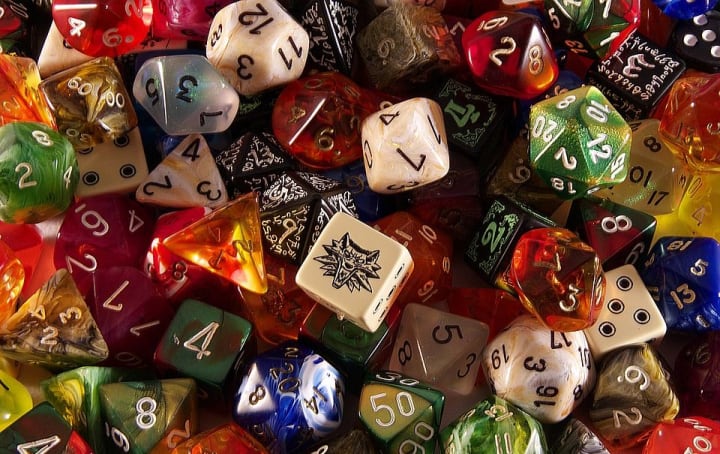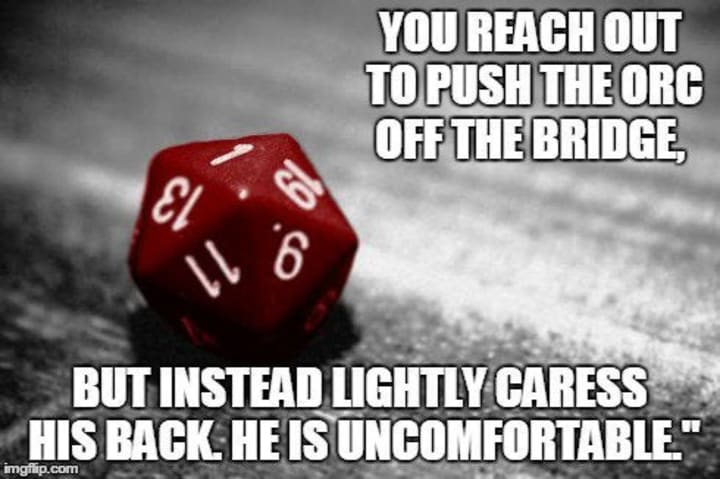Dungeons and Dragons and Dice Rolls: Wait, you use how many dice?
A guide to multi-sided dice, and what rolling them means for your quest

Nobody wants to do math for fun. Well, maybe some people do. I am not one of those people and the prospect of getting my head around what feels like an infinitely complex system of numbers makes me break out into a nervous sweat. Seriously. But the great thing about D&D is that even though the dice rolls look complicated, once you get your head around the basic system, it's actually really simple. Plus there are dozens of apps and handy sites out there you can use that make it easier (i.e. work out the complicated maths) for you.
Dice rolls are quintessential to the D&D experience. The phrase 'we'll let the dice decide' echoes ominously around the (virtual) table whenever something's about to happen and can lead to some fantastically unexpected outcomes as well as some spectacular failures. A prime example of this was in session one of Maeve's (the Bard) outing. Attacked by orcs riding dire-wolves, Maeve ran forward towards a small group that were rushing one of her friends and attempted 'animal friendship' on two of the direwolves. In order for it to work, the wolves had to make what's called a 'saving throw' and score higher than a 16. They did not, meaning that for the last two sessions, we've had two direwolf companions travelling with us that are hanging on Maeve's every word. This had not been planned by the DM at all, which left us all feeling pleased at having thrown a curveball at a DM who has been playing for over thirty years.

The most common dice you'll find is a D20. This is twenty sided die and is used any time you want to know if an attempt at doing something (attacking, avoiding being attacked, checking for traps, deceiving or charming someone... the list goes on) is successful. Most of the time, you're looking to roll higher than the DM or higher than a pre-set score for a successful roll. The higher your roll, the better your chances of success. The best roll you can have is what's called a 'natural 20', which means that you're not only successful, but you're cinematically successful.
On the flip side, if you roll at 'natural 1', this is considered a critical failure. This means instead of firing your arrow at your opponent, you fumble at the last minute and shoot yourself in the foot, or get your fingers tangled in the bow string meaning it snaps. It can mean that instead of successfully convincing the King of the Gnomes to let you go in flawless Gnomish, you insult his mother, his sister and his grandmother resulting in him sentencing you to immediate death.

Other dice are used mostly for damage or healing, often commonly a D4 (four sided die that is used most often to determine how much it hurts to be stabbed by a small blade) and D6 (the traditional die you'll recognise from playing snakes and ladders, which is used for most other types of damage). There are variations, and some very powerful attacks will go so far as to use D8, D10 or D12.
Using dice to control the outcome of certain events creates an element of unpredictability to encounters, ensuring players (and DMs) have to think on their feet when a roll in unexpectedly good. Or bad. Knowing that the success of your action is in the hands of the Gods of Randomness definitely makes you think before leaping into something. Despite the main beats of the story already being planned out, the spontenaity of a dice roll going the wrong way (for either the player or DM) helps keep everyone on their toes.
A good DM will help you understand the intricasies of each dice roll and what that means for your character but there are also a number of other things that you could do to help you process the tricky mathematics needed to handle rolling the die: Beyond20 is a browser add on that can complete the rolls for you, and if you're a subscriber to DnDBeyond, their virtual dice roll when you click on your stat and modifier (and over the next week, they're also offering a really beautiful set of virtual dice for $14.99 and half of the proceeds are going to support various Black Lives Matter causes and bail funds. And they're really beautiful dice.)

You don't need to have manual dice to roll around, especially if you're only playing online (as we all are right now, due to necessary social distancing measures) but there's nothing like the sound of multiple dice rolling across a tabletop.
That's it for this installment, get rolling and we'll talk about character creation and some of the various online tools available next time! May the dice be with you.





Comments
There are no comments for this story
Be the first to respond and start the conversation.